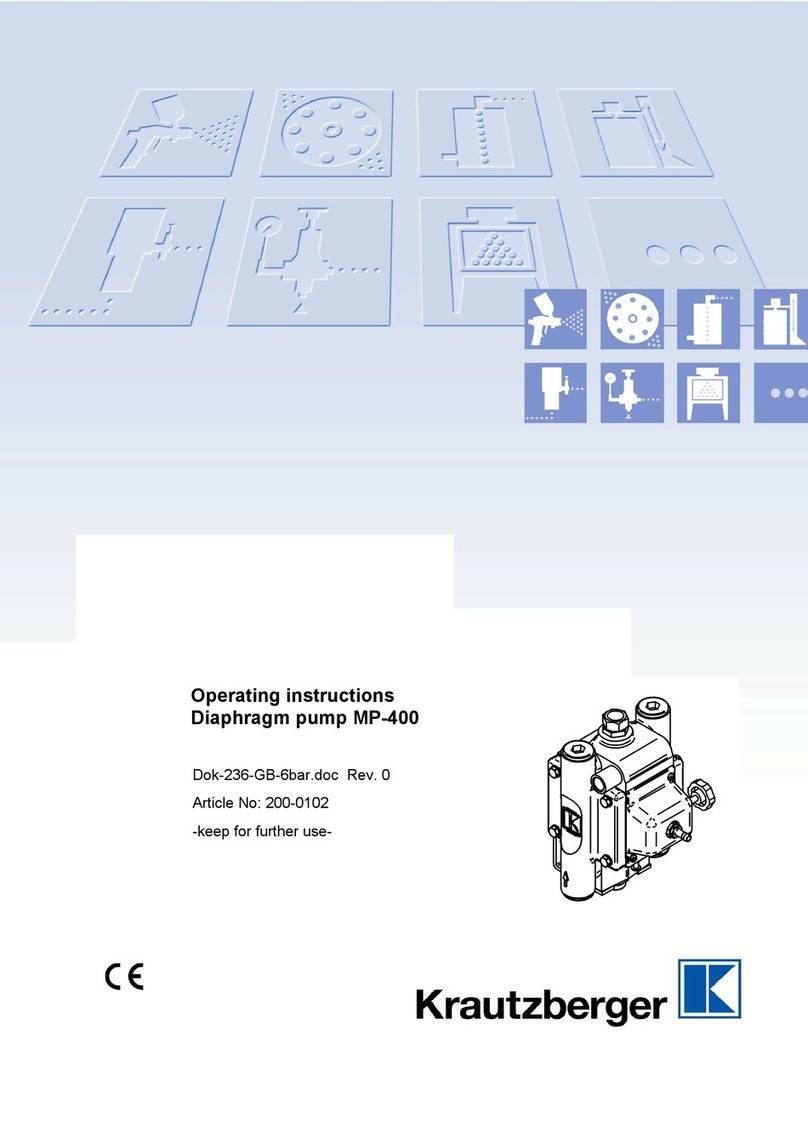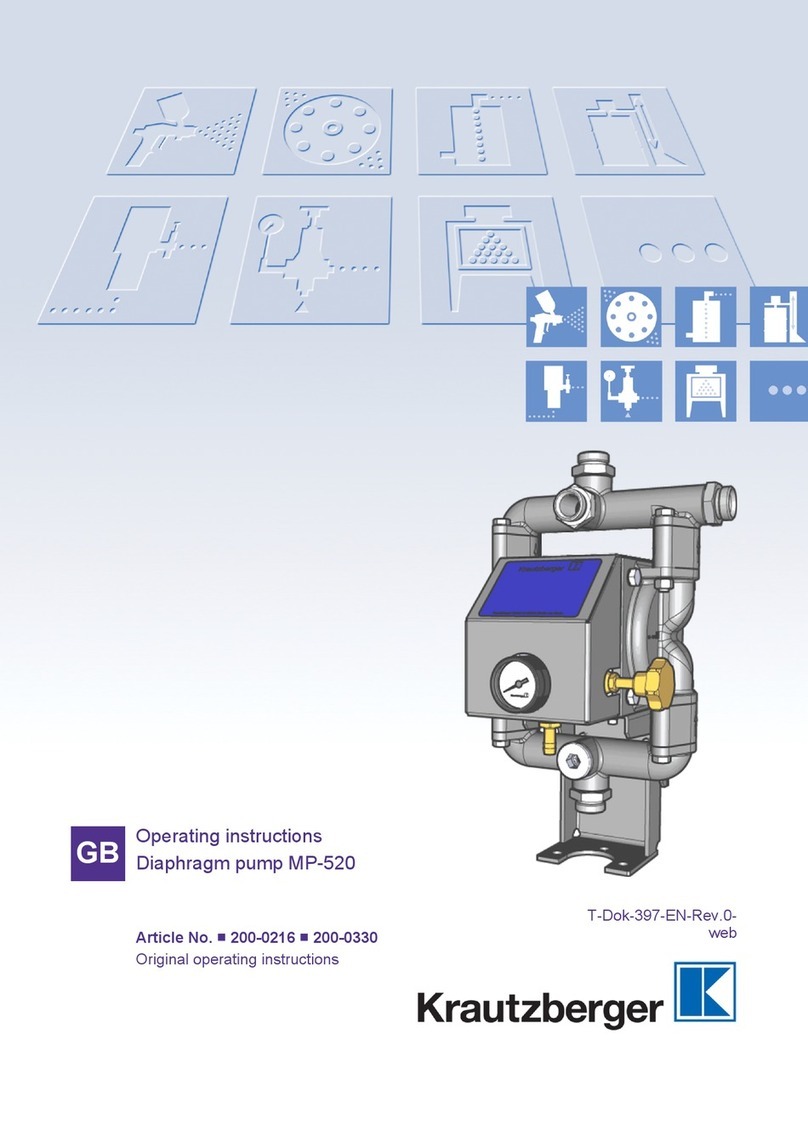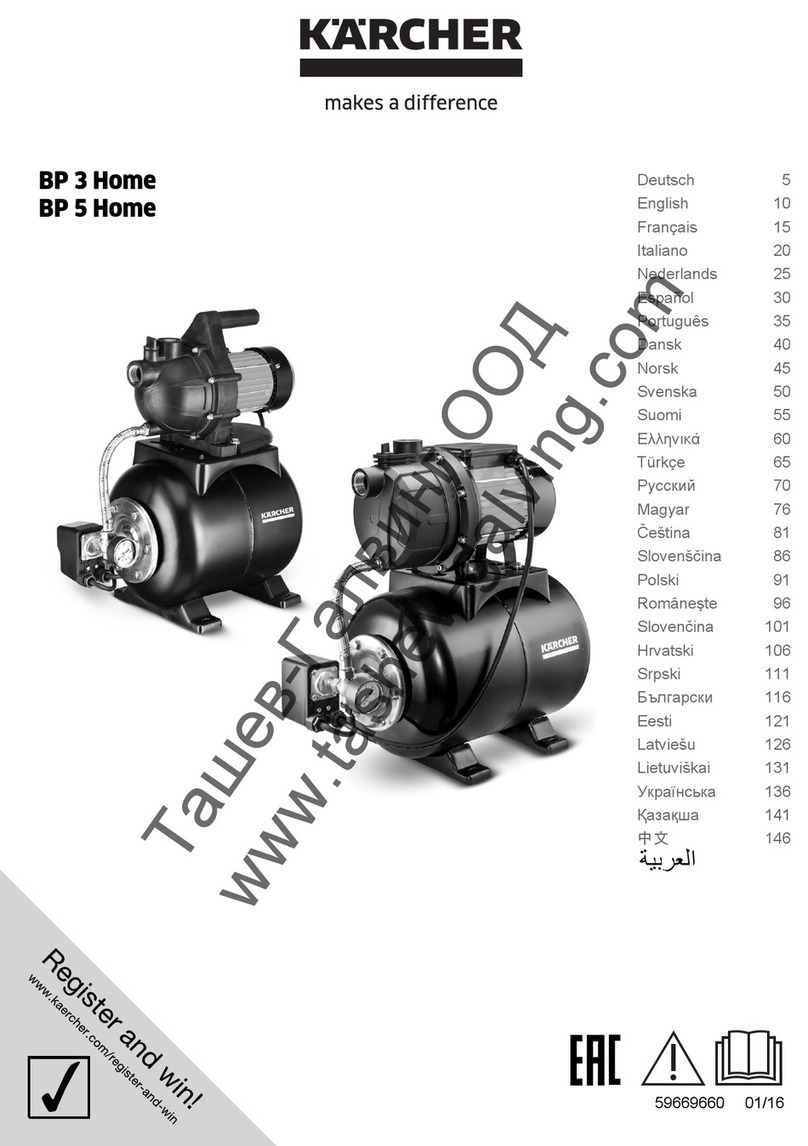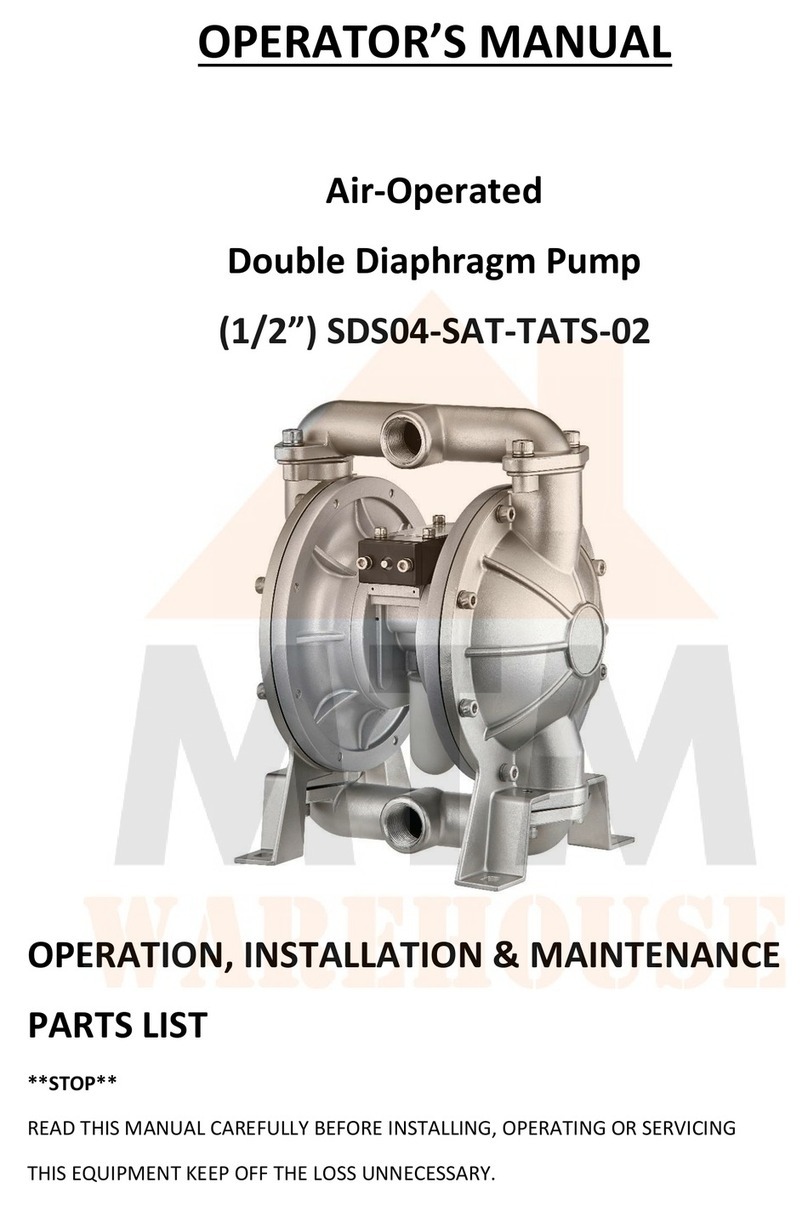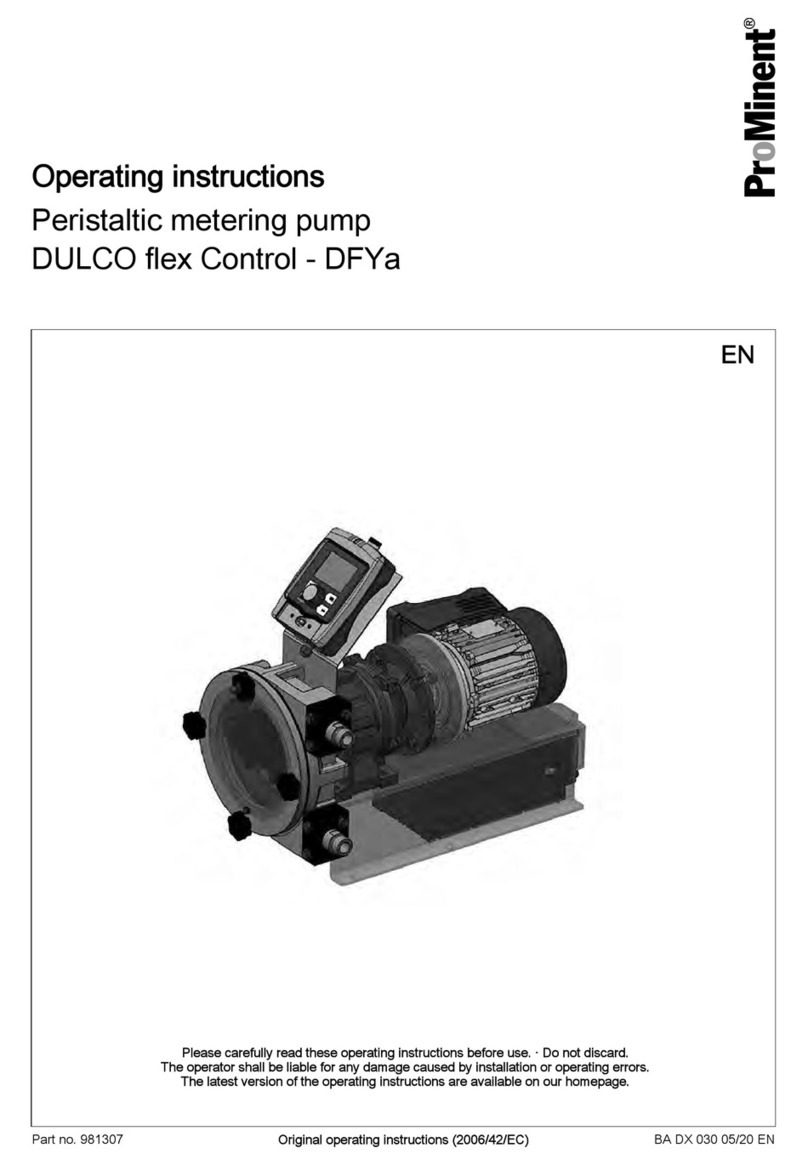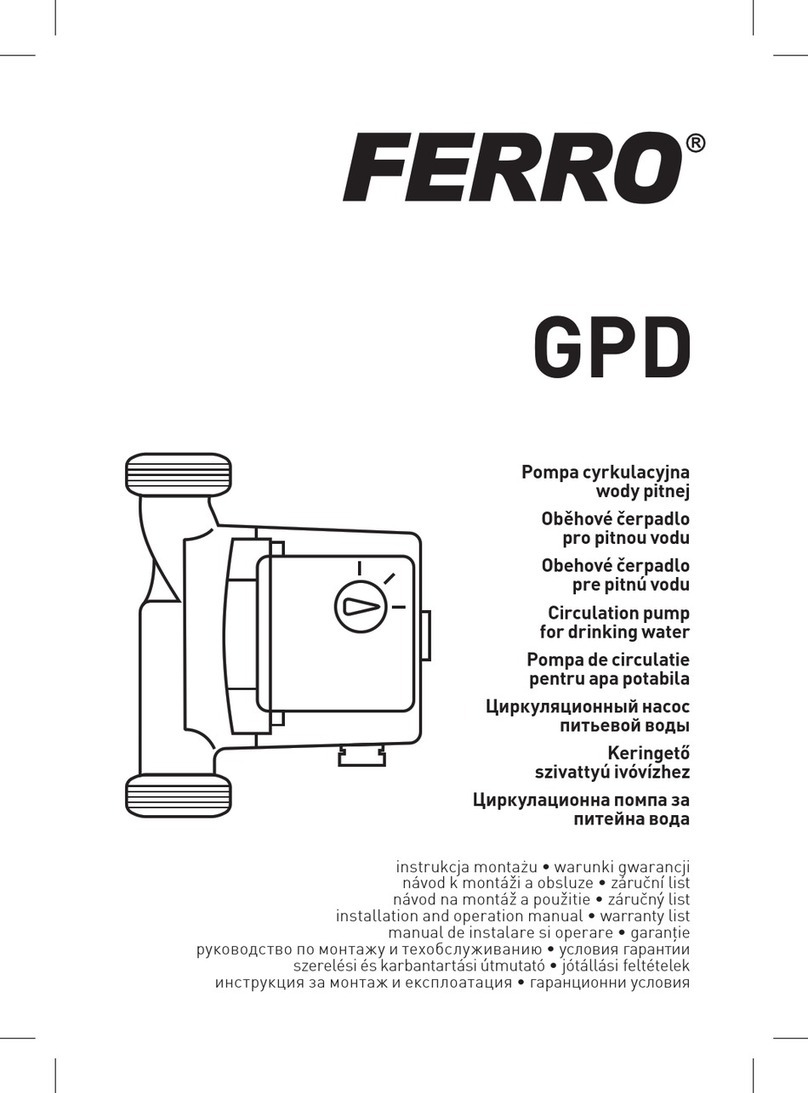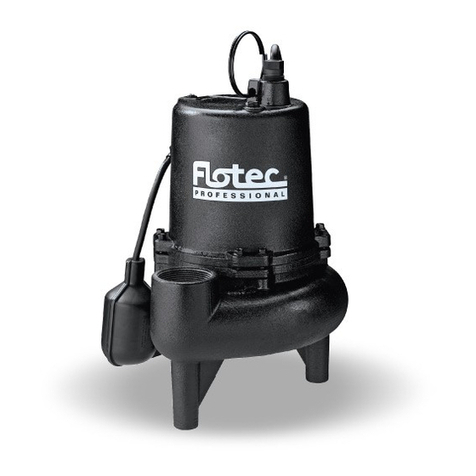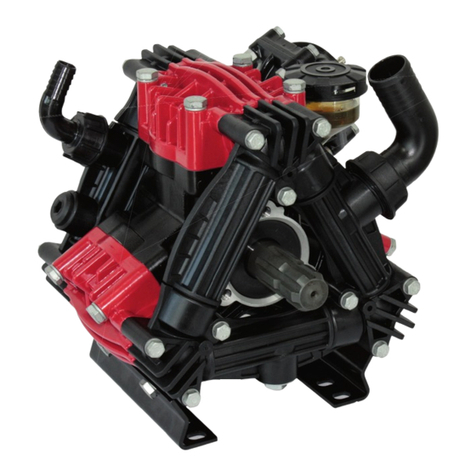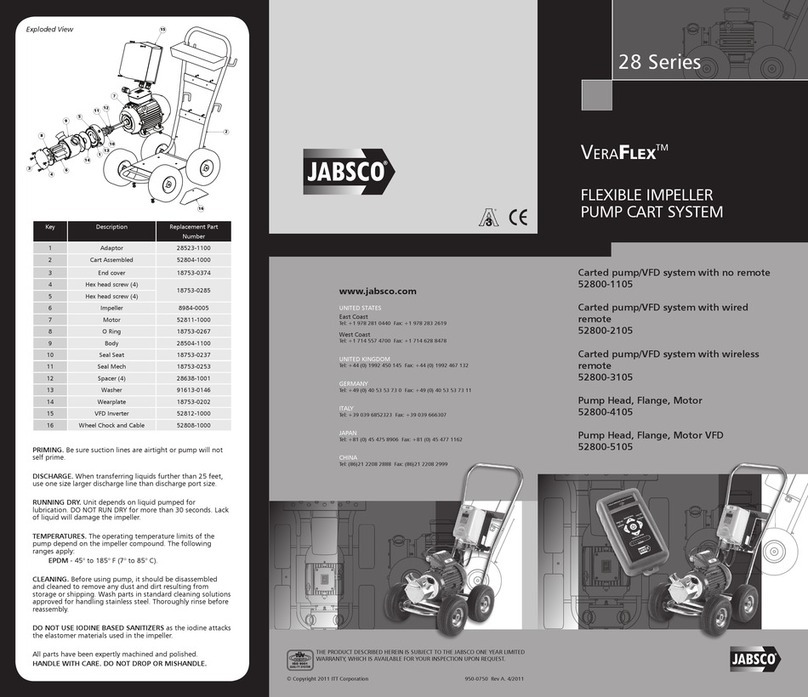Krautzberger MP-100 User manual

■ Article No. 200-0104
Translation of the original operating instructions
T-Dok-237-DE-Rev.0
GB Diaphragm pump MP-100
Operating instructions

[email protected], www.krautzberger.com GB–2
Thank you for selecting a Krautzberger product.
This product has been manufactured according to the latest manufacturing procedures and with
extensive quality assurance measures. We promise you a product of the highest quality
If you have questions, desires or suggestions, please contact us; we are always glad to assist you.
Information about the topic of Ex protection
Many of our competitors have been identifying their products with the Ex symbol for a while now.
Krautzberger does not do this.
We construct and manufacture our products according the currently-valid guidelines.
If the marking on the product is required, then it is affixed on the product as the result of the neces-
sary analysis of ignition sources. If no marking is affixed, then the required analysis of ignition
sources as well as previous experience with the assessment of the applicability of the products in
the Ex area showed that the product described in these operating instructions provides no potential
source of ignition with the exception of the electrostatic charge.
Taking into account the potential equalisation (due to proper earthing), use in the Ex area is admis-
sible according to the currently-valid guidelines.

Table of contents
1 Safety................................................................................................................................... 4
1.1 DESIGNATED USE..................................................................................................... 4
1.2 Personnel requirements............................................................................................... 5
1.3 Personal protective equipment.................................................................................... 5
1.4 Disposal....................................................................................................................... 6
2 Technical data..................................................................................................................... 7
2.1 Dimensions.................................................................................................................. 7
2.2 General specifications................................................................................................. 7
2.3 Fluid conveyance properties........................................................................................ 8
3 Structure and function....................................................................................................... 9
3.1 Overview...................................................................................................................... 9
3.2 FUNCTIONAL DESCRIPTION.................................................................................... 9
4 Mounting and connection................................................................................................ 10
4.1 Mounting the diaphragm pump.................................................................................. 10
4.2 Connection example.................................................................................................. 11
4.3 Connecting the diaphragm pump............................................................................... 12
5 Operation........................................................................................................................... 13
5.1 Commissioning.......................................................................................................... 13
5.2 Interrupting operation................................................................................................. 15
6 Maintenance...................................................................................................................... 16
6.1 Maintenance schedule............................................................................................... 16
6.2 Maintenance work...................................................................................................... 17
7 Faults................................................................................................................................. 24
8 Spare parts/accessories.................................................................................................. 25
8.1 Spare parts................................................................................................................ 25
8.2 Accessories............................................................................................................... 28
9 EU declaration of conformity.......................................................................................... 29
Diaphragm pump MP-100 ENGLISH
■ Article No. 200-0104
GB–3

1 Safety
Safety instructions
DANGER!
This combination of symbol and signal word indicates an immediately dangerous situation
which causes death or severe injuries if it is not avoided.
WARNING!
This combination of symbol and signal word indicates a possibly dangerous situation which
can cause death or severe injuries if it is not avoided.
CAUTION!
This combination of symbol and signal word indicates a possibly dangerous situation which
can cause slight injuries if it is not avoided.
NOTICE!
This combination of symbol and signal word indicates a possibly dangerous situation which
can cause property and environmental damage if it is not avoided.
This symbol highlights useful tips and recommendations as well as information for efficient
and fault-free operation.
Symbol Explanation
Indicates step-by-step instructions.
ðIndicates a condition or an automatic sequence as the result of an action.
Indicates references to sections of these instructions and other applicable
documents.
Indicates enumerations and list entries without a specified sequence.
1.1 DESIGNATED USE
The diaphragm pump MP-100 is a pump operated with compressed air and is used exclusively
Operating instructions T-Dok-237-DE-Rev.0
[email protected], www.krautzberger.com GB–4

nfor the conveying of liquid and low-viscosity coatings from pressureless storage containers,
nfor the supply of fluid to spray guns. automatic spray guns, metering devices and similar.
It is mainly used for painting and coating operations.
Designated use also includes observance of all details in these instructions.
Any use beyond the designated use or any other use counts as misuse.
WARNING!
Danger due to misuse!
Misuse of the diaphragm pump can cause dangerous situations.
–Always observe the valid safety, accident prevention, occupational safety and environ-
mental protection regulations valid for the area of application of the diaphragm pump.
–Only use sharply abrasive, chemically-aggressive, very hot or very cold spray fluids in
consultation with Krautzberger GmbH.
–Only use the manufacturer's original spare parts.
–Only operate the diaphragm pump while adhering the values specified in the
Ä
Chapter
2 ‘Technical data’ on page 7.
–Only operate the diaphragm pump after proper fastening on a suitable carrier construc-
tion.
–Do not hold the diaphragm pump in your hand during operation.
–Heed the spray fluid manufacturer's safety datasheets.
–Do not use the diaphragm pump in the food or pharmaceutical sectors.
Claims of any type due to damage based on misuse are excluded.
1.2 Personnel requirements
Ensure the use of the device by skilled employees! Only skilled employees can independently
detect and avoid possible dangers during use based on their professional training, experience and
knowledge of the relevant regulations.
1.3 Personal protective equipment
When using the device, always wear breathing, eye and ear protection!
Only wear approved protective gloves during cleaning work with solvents!
Diaphragm pump MP-100 ENGLISH
■ Article No. 200-0104
GB–5

1.4 Disposal
When the useful life of the device has been exhausted, dispose of it in commercial waste. In order
to prevent damage to the environment, dispose of any remains of spray fluid properly separately
from the device.
Operating instructions T-Dok-237-DE-Rev.0
[email protected], www.krautzberger.com GB–6

2 Technical data
2.1 Dimensions
Fig. 1: Dimensions
2.2 General specifications
Data Value Unit
Pump capacity (with respect to water, free flow) 10 l/min
Fluid connection (outlet) G 1/2 interior thread Inches
Max. temperature of the coating material used 0 ... +50 °C
Max. pressure 6,5 (94,3) bar (psi)
Max. operating pressure 8 (116) bar (psi)
Compressed air connection (hose sleeve) 8/9 mm
Min. air intake pressure 4 (58) bar (psi)
Max. air intake pressure 8 (116) bar (psi)
Max. stroke (double strokes) 120 DS/min
Recommended number of strokes (double strokes) 100 DS/min
Weight 5,0 kg
Diaphragm pump MP-100 ENGLISH
■ Article No. 200-0104
GB–7

Data Value Unit
Air consumption (at 8 bar) 80 l/min
Transformation ratio 1:1
Compressed air supply oil-free, filtered
2.3 Fluid conveyance properties
Fluid Suitability
Paint (with solvent) good
Water-based paint, dispersions, wood preservatives good
Water good
Oils, heating oils, diesel fuel good
Emulsions, soap, detergents good
Alcohol, glazes, latex limited
Lime sludges limited
Cell and fibre materials unsuitable
Sludge, mash, pastes unsuitable
In case of doubt about suitability, inquire about materials not listed. In special cases we will
determine the suitability in an experiment.
Operating instructions T-Dok-237-DE-Rev.0
[email protected], www.krautzberger.com GB–8

3 Structure and function
3.1 Overview
Fig. 2: Overview
1 Cover hood
2 Surge tank connection
3 Fluid pressure connection
4 Fixing bracket
5 Fluid intake connection
6 Compressed air regulator
7 Compressed air connection
3.2 FUNCTIONAL DESCRIPTION
The pressure desired at the extraction point can be adjusted steplessly using the compressed air
regulator (Fig. 2/6). As soon as the set fluid pressure has been reached, the diaphragm pump
switches off automatically. The fluid pressure is maintained until fluid is extracted at the extraction
point. The diaphragm pump switches on automatically and keeps the set fluid pressure constant.
Diaphragm pump MP-100 ENGLISH
■ Article No. 200-0104
GB–9

4 Mounting and connection
4.1 Mounting the diaphragm pump
Fig. 3: Mounting
Mount the diaphragm pump vertically with the fixing brackets (Fig. 3/1 and 2) and suitable
fastening screws, with the fluid intake connection (Fig. 3/3) facing downward, on a wall or
supporting structure.
Screw onto the earthing with the fixing bracket (Fig. 3/2).
WARNING!
Danger to life due to electrostatic charge!
Electrostatic charges can cause shocks and spark formation and thus explosions.
–Ensure proper earthing.
Operating instructions T-Dok-237-DE-Rev.0
[email protected], www.krautzberger.com GB–10

4.2 Connection example
Fig. 4: Connection example
1 Ball cock
2 Diaphragm pump MP-100
3 Surge tank
4 Screw connection
5 Fluid filter
6 Reduction
7 Fluid regulator
8 "low pressure" tube with fitting
9 Spray gun
10 Air regulator unit with filter
11 Intake hose with suction cage
Diaphragm pump MP-100 ENGLISH
■ Article No. 200-0104
GB–11

4.3 Connecting the diaphragm pump
Fig. 5: Connection
1. Connect the intake hose to the fluid intake connection (Fig. 5/3).
2. Connect the fluid pressure hose to the fluid pressure connection (Fig. 5/2).
The fluid pressure connection can be made on the left or right. Screw the sealing
screw (Fig. 5/2) into the unused connection.
3. If necessary, connect the surge tank to the connection (Fig. 5/1).
4. Connect the compressed air supply to the compressed air connection (Fig. 5/4).
The compressed air supply must be dry, free of oil and secured by an excess pressure
safety valve.
There must be a suitable shut-off device (e.g. Fig. 4/1) installed in order to be able to
switch the diaphragm pump off quickly in case of a breakdown.
5. Check all connections to ensure a tight fit.
Operating instructions T-Dok-237-DE-Rev.0
[email protected], www.krautzberger.com GB–12

5 Operation
WARNING!
Danger of injury due to improper mounting and commissioning/operation!
–Only carry out the mounting and commissioning according to the steps described in
these operating instructions.
–Never direct the compressed air towards people.
–Check the fluid and compressed air hose lines before each use for damage and tight fit.
–Make sure that the hose lines used fulfil the requirements with respect to pressure,
chemical and mechanical loads.
–Make sure that the connected compressed air is oil-free and free of solid matter.
–Observe the details of the spray fluid manufacturer on the safety datasheet.
5.1 Commissioning
Observe the operating instructions for the components in question.
Diaphragm pump MP-100 ENGLISH
■ Article No. 200-0104
GB–13

1. Check the fluid and compressed air lines to make sure they are whole and fit tightly.
2. Switch on the compressed air supply.
3. Make sure that there is air pressure of 4 to 8 bar.
4. Make sure that the fluid intake hose is dipped into the fluid.
Fig. 6: Compressed air regulator
5.
NOTICE!
Increased wear if run in idle!
On initial commissioning, there is still air in the diaphragm pump and the supply lines.
In idle, the diaphragm pump wears especially.
To bleed the pressure regulator (Fig. 6/1), first set a low air pressure.
6. Activate the extraction point (e.g. manual spray gun) until fluid escapes.
7. After successful bleeding, set the desired fluid pressure with the pressure regulator.
Operating instructions T-Dok-237-DE-Rev.0
[email protected], www.krautzberger.com GB–14

5.2 Interrupting operation
Fig. 7: Compressed air regulator
1. Clean diaphragm pump (
Ä
Chapter 6.2.1 ‘Cleaning the diaphragm pump’ on page 17).
2. De-pressurise the diaphragm pump by turning out the compressed air regulator (Fig. 7/1).
3. Interrupt the compressed air supply in a suitable location (e.g. shut-off device).
4. Release the fluid pressure by activating the extraction point.
Diaphragm pump MP-100 ENGLISH
■ Article No. 200-0104
GB–15

6 Maintenance
Hose and pipelines
The service life of hose and pipelines is limited even with proper use by environmental influ-
ences. For the sake of prevention, all hose and pipelines should be replaced regularly
according to their load.
6.1 Maintenance schedule
The following sections describe the maintenance work that is required for optimal and fault-free
operation of the device.
Check wearing parts such as seals at regular intervals. The level of wear depends on the abrasive-
ness of the spray fluid used. Escaping air and spray fluid are signs that parts are worn. In case of
questions about maintenance work and intervals, contact the manufacturer; see contact data on
the last page.
Interval Maintenance work Personnel
After each use Clean diaphragm pump (
Ä
Chapter 6.2.1 ‘Cleaning the
diaphragm pump’ on page 17).
Qualified personnel
When required Replace valve parts (
Ä
Chapter 6.2.2 ‘Replacing valve
parts’ on page 18)
Qualified personnel
Replace diaphragms (
Ä
Chapter 6.2.3 ‘Replacing the
diaphragms’ on page 20)
Qualified personnel
Operating instructions T-Dok-237-DE-Rev.0
[email protected], www.krautzberger.com GB–16

6.2 Maintenance work
6.2.1 Cleaning the diaphragm pump
WARNING!
Danger of injury due to improper cleaning!
–Observe the safety datasheets of the detergent manufacturer.
–Do not use any halogenated detergents.
1. Interrupt the compressed air supply in a suitable location (e.g. shut-off device).
2. Dip the fluid intake hose into a suitable detergent.
3. Switch on the compressed air supply.
4. Rinse out the diaphragm pump by activating the extraction point until only detergent liquid
escapes.
5. Disconnect the compressed air supply.
6. Leave detergent liquid in the pump.
7. Clean the outside of the device with a cloth dipped in detergent.
Diaphragm pump MP-100 ENGLISH
■ Article No. 200-0104
GB–17

6.2.2 Replacing valve parts
Special tool:
nSpecial pulling tool
1. Clean diaphragm pump (
Ä
Chapter 6.2.1 ‘Cleaning the diaphragm pump’ on page 17).
2. Make sure that the compressed air supply is switched off.
3. If necessary, release the fluid pressure by activating the extraction point.
Fig. 8: Valve parts
4. Unscrew the double nipple (Fig. 8/1 and 9).
5. Remove the ball guides (Fig. 8/2 and 6) and valve balls (Fig. 8/3 and 7).
6. Remove the valve seats (Fig. 8/4 and 8).
Required special pulling tool is included in the tool kit (article no. 120-0638).
7. Check all parts for damage and wear, replace if necessary.
8. Clean the valve housing.
Operating instructions T-Dok-237-DE-Rev.0
[email protected], www.krautzberger.com GB–18

The double nipples (Fig. 8/1 and 9) are inserted with glue for solvent-proof screw
sealing. This glue must be removed completely.
9. Grease valve housing and O-rings (Fig. 8/5 and 10) slightly.
10. Make sure that the O-rings (Fig. 8/5 and 10) are mounted correctly on the valve seats.
11. Mount the valve seats (Fig. 8/4 and 8).
12. Insert the ball guides (Fig. 8/2 and 6) and valve balls (Fig. 8/3 and 7).
13. Apply glue to the double nipples (Fig. 8/1 and 9) for solvent-proof screw sealing and screw
in.
14. Clean the diaphragm pump (
Ä
Chapter 6.2.1 ‘Cleaning the diaphragm pump’ on page 17)
and perform a test run (
Ä
Chapter 5.1 ‘Commissioning’ on page 13).
Diaphragm pump MP-100 ENGLISH
■ Article No. 200-0104
GB–19

6.2.3 Replacing the diaphragms
1. Clean diaphragm pump (
Ä
Chapter 6.2.1 ‘Cleaning the diaphragm pump’ on page 17).
2. Make sure that the compressed air supply is switched off.
3. If necessary, release the fluid pressure by activating the extraction point.
Fig. 9: Cover hood
4. Remove the compressed air connection (Fig. 9/1).
5. Unscrew the star handle (Fig. 9/2) from the pressure regulator.
6. Unscrew the screw (Fig. 9/4) and remove the cover hood (Fig. 9/3).
Fig. 10: Timing case
7. Loosen all 4 nuts (Fig. 10/1) and remove the timing case (Fig. 10/2).
Operating instructions T-Dok-237-DE-Rev.0
[email protected], www.krautzberger.com GB–20
Table of contents
Other Krautzberger Water Pump manuals
Popular Water Pump manuals by other brands

vacuubrand
vacuubrand PC 510 NT Instructions for use

Pfeiffer Vacuum
Pfeiffer Vacuum OKTA 18000 operating instructions

Monzana
Monzana 103206 instructions
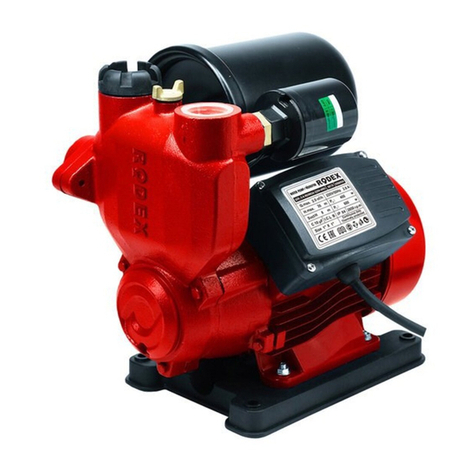
RODEX
RODEX RDX8634 instruction manual

GORMAN-RUPP PUMPS
GORMAN-RUPP PUMPS GMS1 1/2 Installation, operation and maintenance manual
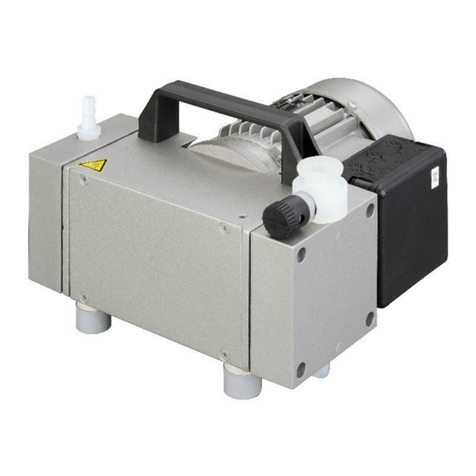
Welch
Welch MP 601 E Operation manual
